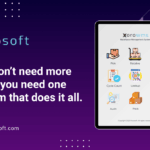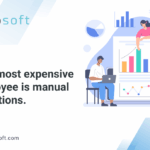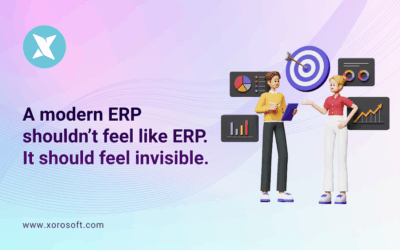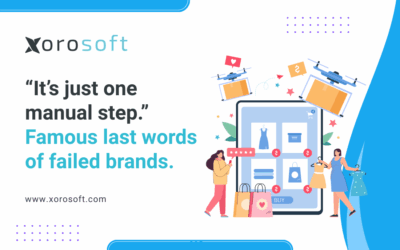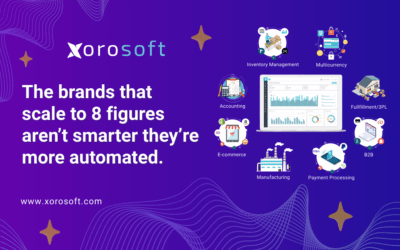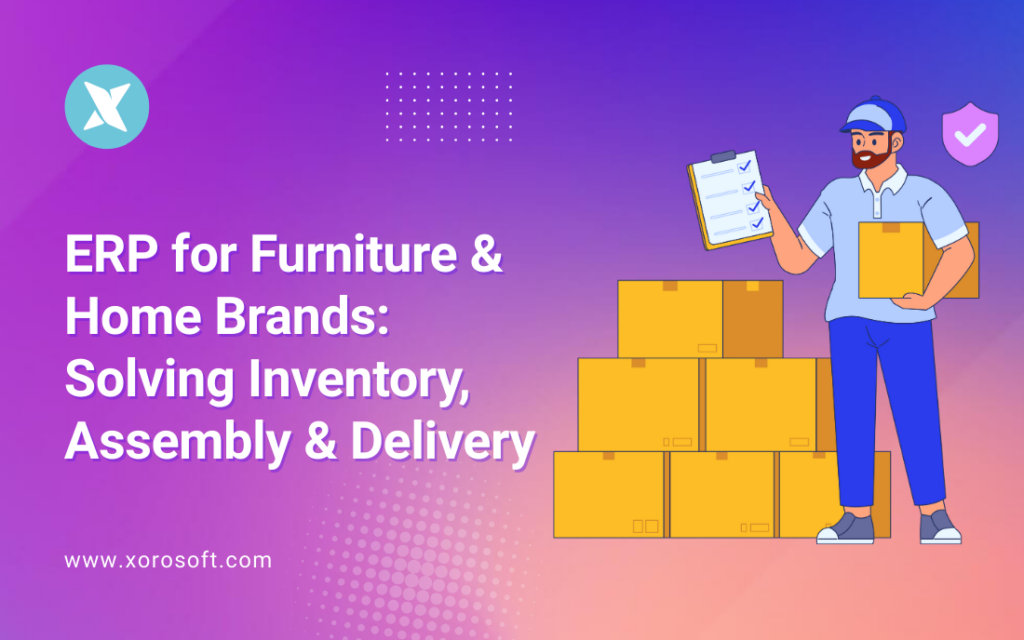
The Hidden Chaos in Everyday Furniture Operations
ERP for furniture brands turns complex operations into one reliable flow. Moreover, it keeps inventory accurate, coordinates assembly, and ensures trucks leave complete. Consequently, the customer experience stays intact, reviews trend positive, and margins hold.
Furniture and home brands look glamorous from the outside. However, inside the business, gaps appear quickly. Hardware shows up late, crews misplace a carton of legs, and a truck loads the wrong configuration. As a result, orders slip, customers complain, and teams scramble to recover.
In truth, the product rarely fails. Instead, coordination fails when tools don’t connect and no one sees the same source of truth.
Operational Risks You Can’t Ignore (And How They Erode Margin)
Furniture isn’t simple.
Complex Products With Multiple SKUs
For example, a sectional might include a frame, arms, cushions, brackets, and a hardware kit. If one item goes missing, the delivery stalls or the truck returns.
Made-to-Order Complexity
Moreover, made-to-order options multiply combinations and raise human error risk.
Delivery and Returns
In addition, bulky deliveries raise pressure and cost. A missed hand-off between warehouse and logistics doesn’t only delay a shipment—it burns cash and trust.
Returns cut deeper. Consequently, teams must inspect, regrade, and restock multiple parts. Without precise tracking, those tasks drain hours and dollars.
Disconnected Tools
Finally, spreadsheets and bolt-on apps amplify mistakes. Sales might mark an order “ready,” while the warehouse still waits on hardware. Meanwhile, finance posts revenue before the truck even moves. Ultimately, everyone works hard; the systems disagree.
Why Disconnected Systems Create Predictable Chaos
People don’t fail; processes do. The root cause stays the same: tools don’t talk to each other.
Where the Breakdowns Happen
-
First, spreadsheets sit still and never reflect real-time moves.
-
Second, accounting software manages books yet collapses under multi-SKU assemblies.
-
Third, shipping apps see orders too late to prevent errors.
-
Finally, manual updates travel by email and chat, so key details never reach every role.
Because data lives in silos, sales overpromises, procurement reorders late, and logistics fixes problems on the curb. Consequently, as volume grows, those cracks widen into chronic issues.
Why ERP for Furniture Brands Is Now Non-Negotiable
Modern leaders switch to a unified core when band-aids stop working. ERP for furniture brands connects inventory, procurement, warehouse, logistics, and finance in one source of truth.
Therefore, teams prevent errors instead of reacting to them.
Benefits of ERP for Furniture Brands
-
Real-time inventory control: Everyone sees accurate quantities across locations and inbound POs.
-
BOM intelligence: The system links each component to the finished good, so crews stage complete sets.
-
WMS precision: Workers follow optimized picks for bulky items and stage orders by stop.
-
Delivery orchestration: Schedules update instantly; trucks leave fully prepared.
-
Live margin visibility: Finance tracks COGS and profit as orders move, not just after month-end.
As a result, costs fall, speed improves, and customers notice the difference.
How Xorosoft Unifies Inventory, Assembly, and Delivery
This is where Xorosoft ERP steps in. Because the platform is cloud-native, it replaces the patchwork that slows teams down and scales with growth.
What Sets Xorosoft Apart
-
Inventory & assembly control
Xorosoft tracks multi-component SKUs and BOMs end-to-end. Consequently, teams confirm frames, cushions, legs, and hardware before staging, so trucks leave complete. -
Warehouse management baked in
Xorosoft includes a robust WMS. Staff scan moves in real time, follow efficient pick paths, and stage bulky goods by route. In turn, the dock stays organized. -
Multi-channel selling, one dashboard
Sell on Shopify, Amazon, wholesale, and retail—then manage everything in one place. See it on the Shopify App Store. -
Automation that removes double work
Purchasing, warehouse, delivery, and accounting share the same live data. Therefore, teams stop rekeying and stop chasing updates. -
Usability customers recognize
G2 ranks Xorosoft #1 in Ease of Use for ERP systems and lists it as a High Performer. Explore the ranking on G2.
ERP for Furniture Brands in the Real World: A Day in the Life
A customer orders a dining table set. Immediately, the ERP checks inventory for the tabletop, legs, chairs, and hardware. In addition, the system confirms substitutions when a component runs low.
The WMS assigns picks by zone and groups items by stop. Next, logistics books the window and pushes updates to the buyer. Meanwhile, finance sees live margin after freight and handling.
Delivery day arrives. The crew unloads, assembles, and closes the job in the app. Consequently, the system posts revenue and requests a review. Nothing slips; the customer leaves five stars.
Protect Reviews by Engineering Reliability
Design wins attention; reliability wins loyalty.
Why Reliability Matters
One flawless delivery turns a first-time buyer into a fan. Conversely, one broken promise creates a negative review that lingers for years.
Therefore, operational excellence isn’t a back-office goal—it’s your brand strategy. With a unified ERP, you engineer reliability at scale and turn logistics into marketing.
Tangible Wins Leaders Can Bank On
Executives want outcomes, not dashboards. After moving to a unified core, brands report the following gains:
-
Fewer reschedules because crews load full sets the first time.
-
Lower write-offs because teams flag damages and shortages immediately.
-
Faster cash cycles because finance closes jobs upon proof of delivery.
-
Better forecasting because purchasing sees demand, lead times, and inbound POs together.
-
Happier customers because orders arrive on time and in full.
In other words, the business grows calmer as volume rises. As a result, leadership spends more time on growth and less time on fire drills.
Implementing ERP for Furniture Brands Without Disruption
Change can feel risky. Even so, teams move faster when the system fits the way they work.
Implementation With Minimal Friction
Xorosoft runs in the cloud and connects to your channels and 3PL partners. Your team logs in from a browser, scans on mobile, and views the same live numbers. To start, focus on core workflows—inventory accuracy, BOM staging, and delivery orchestration—then expand.
Because the platform supports multi-location, multi-currency, and EDI, you can scale without swapping cores later. Furthermore, role-based permissions keep teams focused.
Proof Beats Promises (And Drives Adoption)
Teams trust software they enjoy using. Xorosoft earns that trust with speed and clarity: quick deployments, clean screens, and role-based views.
Moreover, third-party validation matters. The G2 ranking for ease of use and the live Shopify App listing signal maturity and momentum. Consequently, partners and new hires recognize a platform they can learn quickly and use daily.
Six Months After Go-Live With ERP for Furniture Brands
Six months in, leaders usually report three themes:
-
Visibility replaces guesswork because scans, picks, and deliveries update the same ledger.
-
Discipline becomes habit as the WMS guides picks and prevents incomplete loads.
-
Confidence spreads: sales quotes realistic windows, operations hits them, and accounting closes with fewer surprises.
Hence, the flywheel compounds. As volume rises, the team keeps its cool and the brand looks larger than its headcount.
Transform Inventory, Assembly, and Delivery—Starting Now
You don’t need to live with missing parts, stalled trucks, or tense calls. ERP for furniture brands provides one operating rhythm from PO to proof of delivery.
Explore how Xorosoft ERP unifies your stack, accelerates your teams, and protects your margins. Visit xorosoft.com, review the features and pricing, and book a demo when you’re ready.
Ultimately, when your systems move together, your brand can focus on creating homes people love—and your customers will tell the story for you.


